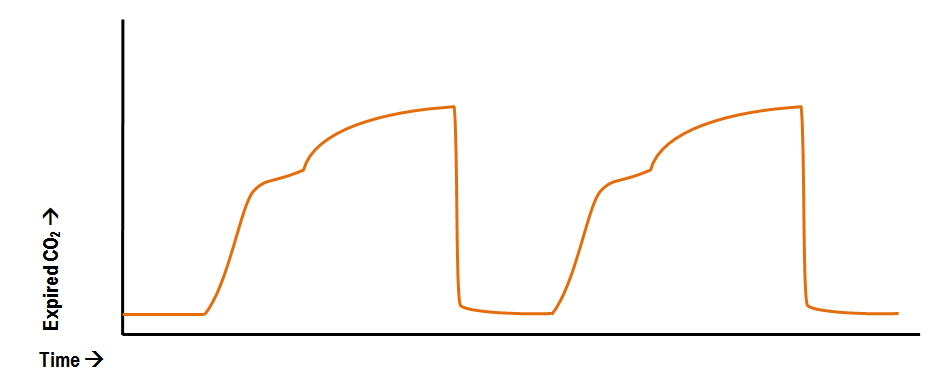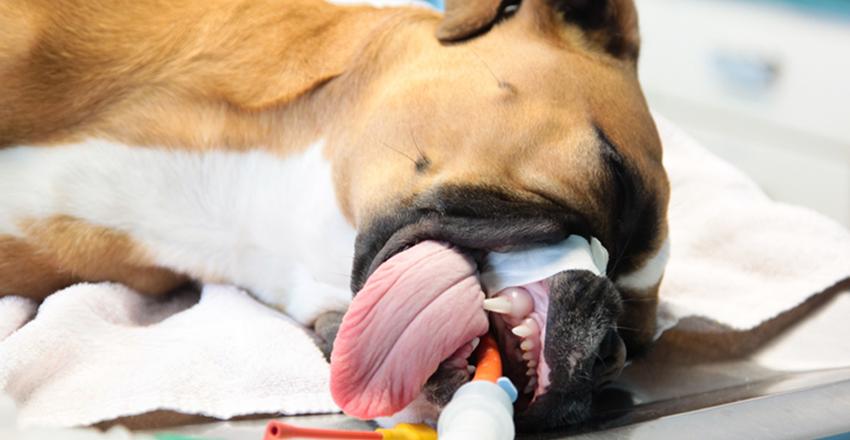normal end tidal co2 dog
It includes the diaphragm and chest muscles the nose and mouth the pharynx and trachea the bronchial tree and the lungs. Heart rate can be monitored from an ECG from a stethoscope esophageal stethoscope pulse oximeter or blood pressure monitor.

Learn More With This Respiratory Article By Melissa Marshall
ETCO 2 is measured by a capnograph in a mainstream or sidestream method.

. Capnography waveforms etCO2 and breathing patterns. Since problems with lungs are not common and gas exchange between alveoli and the blood is swift and effective. PaCO2 PetCO2 End tidal measurement from expired or exhaled air PaCO2 Arterial blood gas sample End tidal normally 2-5 mmHg lower than arterial Comparing Arterial and End-tidal CO2 Review of Airway Confirmation Visualization Auscultation.
Examples of some common capnograms are. Normal range is 35-45mmHg and roughly correlates with the partial pressure of CO2 in arterial blood remember that PaCO2 is usually slightly higher than ETCO2 by 2-5mmHg. 4 to 5 CO2 PetCO2 vs.
Levels that deviate from this range require quick evaluation to determine the appropriate corrective course of action. End-tidal CO 2 monitoring is a non-invasive means of estimating arterial CO 2. Endtidal carbon dioxide ETCO 2 is the measurement of CO 2 in exhaled respiratory gases and serves as an estimate of arterial CO 2.
This is end-tidal CO 2 ETCO 2 which is normally 35 to 45 mm Hg in dogs and 28 to 32 mm Hg in cats. Arterial to end-tidal CO2 tension gradients were measured in 18 dogs during spontaneous breathing SB intermittent positive-pressure ventilation IPPV and both low-frequency and high-frequency jet ventilation LFJV and HFJV. Under most circumstances healthy pet no chest surgery end-tidal CO 2 is typically 5 10 mmHg less than arterial CO 2.
Carbon dioxide CO 2 is linked to a patients perfusion ventilation and metabolism. In fact its commonly called the ventilation vital sign. Negative Epigastric sounds Equal lung sounds Esophageal detector.
The normal end-tidal capnography wave form is basically a rounded rectangle. Yes the generic normal is considered 35-45. Throughout the breath cycle.
Eased etCO2 levels in cats and dogs are 32 to 35 mm Hg and 35 to 46 mm Hg respectively. The capnometer is checked and is in good working order. Capnography in Dogs.
Simultaneous comparison of heart rate ECG or stethoscope with pulse rate palpation or blood pressure monitor allows the anesthetist to pick up some dysrhythmias. Which of the following is the normal ETCO2 end-tidal carbon dioxide level in an anesthetized dog or cat. Well the EtCO2 value is simply a number.
A more complete picture of carbon dioxide transfer can be obtained from a capnogram similar to an ECG tracing. Also called capnometry or capnography this noninvasive technique provides a breath-by-breath analysis and a continuous recording of ventilatory status. The measurement of end-tidal carbon dioxide ETCO 2 allows the continuous monitoring of the adequacy of ventilation and circulation in the anaesthetised patientIt measures inspired and expired carbon dioxide CO 2 throughout the whole respiratory cycle using infrared spectroscopyETCO 2 can be of value in the assessment of ventilation metabolism and of a.
End-tidal carbon dioxide ETco 2 monitoring provides valuable information about CO 2 production and clearance ventilation. The end-tidal level of carbon dioxide is generally less but is reflective of carbon dioxide in arterial blood and can serve as an indirect noninvasive method of assessing the adequacy ventilation. When etCO2 is greater than 40 mm Hg hypercapnia is present more than normal CO2.
2 to near normal normal EtCO 2 35-45 mmHg represents marked increase of CO 2 delivery to lungs suggesting ROSC If patient develops an organized rhythm after VFVTasystole check EtCO 2 to see if ROSC has occurred CONFIRM PLACEMENT OF ETT After intubation if ETCO 2 10mm Hg tube in trachea. In conditions of normal breathing 6 Lmin 12 breathsmin 500 ml for tidal volume etCO 2 is very close to alveolar CO2. The bloodstream heart and brain are also involved.
Repiratory rate AND depth tidal volume which determine minute ventilation and therefore arterial CO2. There was an excellent linear correlation b. Variants of normal ETCO2 tracings from normal anesthetized animals.
What Is A Normal End-tidal Co2 Dog. During surgery an anesthetized 4-year-old mixed-breed dog has an expired CO2 level of 25 mm Hg. Capnography also measures and displays the respiratory rate.
Capnography can be used to measure end-tidal CO 2. The end-tidal carbon dioxide tension PetCO2 measured after a single large tidal-volume breath 15 mlkg body weight was compared to simultaneous measurements of PaCO2 in 6 dogs with normal lungs who were receiving high-frequency jet ventilation HFJV. When a person is breathing in it.
According to the book by Hockenberry and Wilson 2015 p 1140 normal values of ETCO2 are 30-43 mmHg which is slightly lower than arterial PaCO2 35-45mmHg. The capnograph is the waveform that shows how much CO 2 is present at each phase of the respiratory cycle and it normally has a rectangular shape Figure 1. The normal levels of expired CO2 in dogs and cats should between 35 and 45 mm Hg millimeters of mercury.
The CO 2 waveform is a valuable tool for detecting leaks in the anesthetic system rebreathing of CO 2. The dogs were anesthetized with nembutal and permitted to breathe spontaneously through an 8-mm internal diameter. 2 See Figure 1 p.
The respiratory system is the bodys link to its supply of oxygen. However any number of conditions can cause a change that may or may not be considered normal for any given patient. We know that elevated ETCO2 hypercapnia occurs during hypoventilation and a decrease in ETCO2 hypocapnia occurs with hyperventilation.
Normal minute ventilation about 200 mlkgmin for dogs and cats in conscious animals with normal lungs results in an arterial and therefore alveolar CO 2 partial pressure of 35 to 45 mm Hg. 48 When a person is breathing out CO 2 the graph goes up. Most anesthetics are respiratory depressants and end-tidal CO2 allows early detection of respiratory impairment so appropriate intervention can occur before the problem becomes life threatening.
For example a patient in DKA may have a very low EtCO2. Carbon dioxide during ventilation. The plateau observed at the end of the.
The bloodstream takes oxygen from the lungs to the rest of the body and returns carbon dioxide to them. Which of the following is most likely to correct the hypocarbia.
Riding The Wave Of Capnography Understanding Etco2 Vetbloom Blog

Learn More With This Respiratory Article By Melissa Marshall
Did You Know Hypercapnia Is Synonymous With Hypoventilation

Pdf Capnography In Dogs Semantic Scholar

Learn More With This Respiratory Article By Melissa Marshall

Pdf Capnography In Dogs Semantic Scholar

Pdf Capnography In Dogs Semantic Scholar
Riding The Wave Of Capnography Understanding Etco2 Vetbloom Blog

Learn More With This Respiratory Article By Melissa Marshall

Pdf Capnography In Dogs Semantic Scholar

Abnormal Capnography Waveforms And Their Interpretation Deranged Physiology

Learn More With This Respiratory Article By Melissa Marshall

Learn More With This Respiratory Article By Melissa Marshall

Why Monitor End Tidal Carbon Dioxide Rwd Life Science

Learn More With This Respiratory Article By Melissa Marshall
